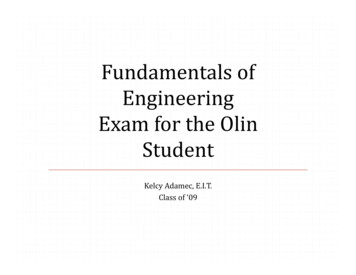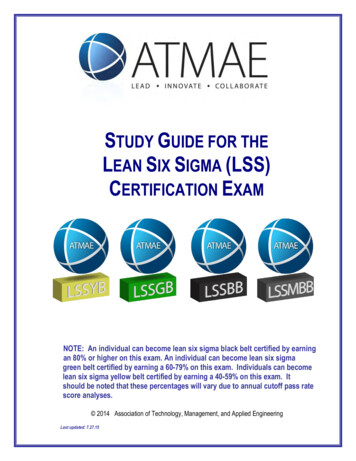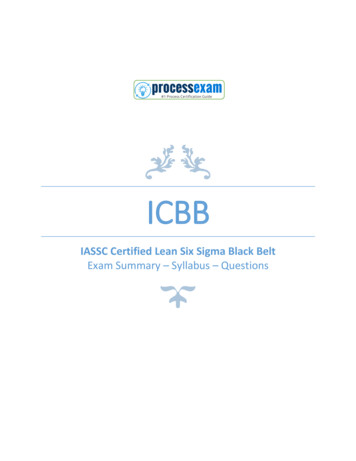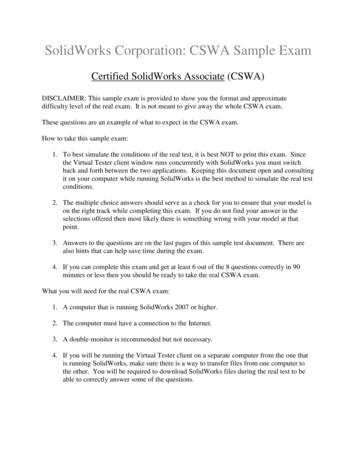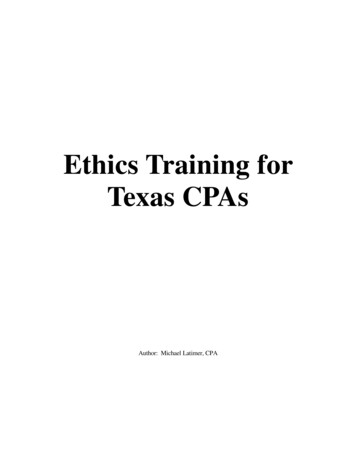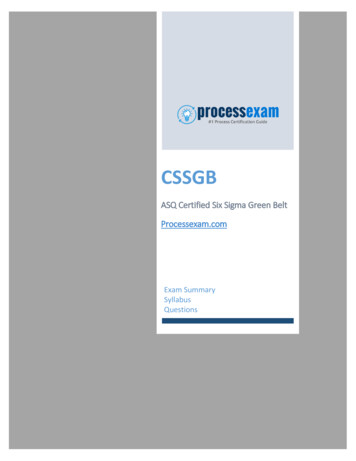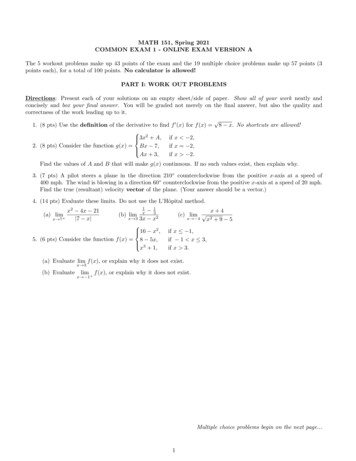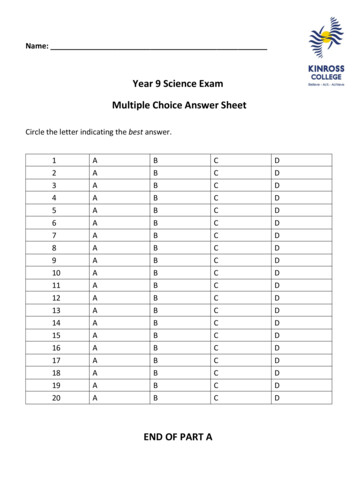
Transcription
Name:Year 9 Science ExamMultiple Choice Answer SheetCircle the letter indicating the best AAAAAAAABBBBBBBBBBBBBBBBBBBBEND OF PART ACCCCCCCCCCCCCCCCCCCCDDDDDDDDDDDDDDDDDDDD
YEAR 9 SCIENCE EXAMINATIONSemester 1, 2018WRITTEN QUESTION AND ANSWER BOOKLETSTUDENT NAME:TEACHER NAME:DATE:Mark AllocationsTopicSectionMarksChemical ScienceMultiple Choice/10Short Answer questions/45Multiple Choice/10Short Answer questions/45Physical ScienceTotalTIME ALLOWED FOR THIS PAPER:Reading time before commencing work:Working time for this paper:/11010 minutes1 hour 50 minutesMATERIAL REQUIRED / RECOMMENDED FOR THIS PAPER:-To be provided by the supervisor:This question and answer bookletsTo be provided by the candidate:- Pens, pencils, ruler, eraserIMPORTANT NOTE TO CANDIDATESNo other items may be taken into the examination room.It is your responsibility to ensure that you do not have any unauthorised notes or other items of a nonpersonal nature in the examination room. If you have any unauthorised material with you, hand it tothe supervisor BEFORE reading any further. All iPads and mobile phones must be turned off and in yourbag along with any other devices and notes. Bags are to be closed and placed under the desk.INSTRUCTION TO CANDIDATES:1. Read through the paper to familiarise yourself with all of the questions.2. Use a blue or black ballpoint / ink pen for the written answers. Use pencil for drawing the graphs.3. Write your answers in this booklet.4. Should you require more space than you have been given please use the spare sheet (at the backof this booklet) and ensure that you include your name and the question / statement to whichyou are responding.
AT THE END OF THE EXAMINATION:- Any planning sheets or other pieces of paper MUST be handed in with this booklet.- At the end of the examination make sure that your name is on your booklet and any other piecesof paper used.Instructions to candidates1. Sitting this examination implies that you agree to abide by the examination rules set down byKinross College.2. Answer the questions in the space provided.3. You must be careful to confine your responses to the specific questions asked and to followany instructions that are specific to a particular question.4. A spare page is included at the end of this booklet. It can be used for planning yourresponses and/or as additional space if required to continue an answer.(a) Planning: If you use the spare page for planning, indicate this clearly at the top of thepage. If you choose to use lined paper for planning, ensure your name and the title isclearly printed.(b) Continuing an answer: If you need to use the space to continue an answer give thepage number. Fill in the number of the question (s) that you are continuing to answerat the top of the page.5. This examination contributes towards your report. If you have any questions, please askthem during the ten-minute reading time.Manage your time wisely. Always provide substantiation (evidence). Make sure that whatyou have written makes sense.
Note: Do not turn the page until you are asked to do so.
Chemical Science Multiple Choice Questions1. The mass number of an atom is the number of:a.b.c.d.protons and electrons in an atom.protons and neutrons in an atom.protons in an atom.electrons in an atom.2.a.b.c.d.Butane is a hydrocarbon fuel. What would the products of the combustion of propane be?Chloromethane and hydrogen chlorideCarbon dioxide and waterCarbon dioxide onlyHydrogen and water3.a.b.c.d.4.a.b.c.Which one of the following can be found in the nucleus of an atom?hydrogenelectronisotopeprotonWhich of the following shows a word equation for a neutralisation reaction?acid base salt hydrogen wateracid base wateracid base salt waterd. acid base salt carbon dioxide water5.a.b.c.d.The 3 radio-active particles are:Alpha Beta and Delta.Alpha Beta and Omega.Beta Delta and Omega.Alpha Beta and Gamma.6. Oxidation reactions are any chemical reaction that:a. absorbs energy from the surroundingsb. involves carbon dioxide.c. Remove oxygen from a compound.d. involves an element combining with oxygen7. Which particle is the heaviest?a. Beta.b. Alpha.c. Gamma.d. Omega.
8.The law of conservation of mass explains why, in a chemical reaction:a. the reactants are heavier than the products.b. energy cannot be created nor destroyed, only transformed or transferred.c. the reactants weigh the same as the products.d. new atoms are created from the reactant atoms.9. What is the electronic configuration (electron arrangement) of a chlorine atom? Hint: Chlorine has anatomic number of 17.a. 2,10,5b. 2,8,7c. 2,2,2,2,2,2,2,2,1d. 8,8,110. A chemical word equation only shows:a. the chemical formulas of the reactants and the products.b. the names of the reactants and the products in words.c. all the atoms in the compounds of the reactants, but not the products.d. all the atoms involved in the reaction and how they rearrange into the products.
Physical Science Multiple Choice Questions11. What type of energy cannot travel across space?a. Sound energyb. Light energyc. Radio energyd. Heat energy12. Sound is a longitudinal wave. This means that particles being moved by sound energy will:a. vibrate up and downb. move along with the wavec. vibrate from side to sided. do not move at all13. The structure in the human ear that changes sound energy into electrical energy is the:a. auditory nerve.b. eardrumc. cochlead. middle ear14. The spoon in the diagram appears distorted.This can be explained by which property of light?a. total internal reflectionb. refractionc. reflectiond. dispersion15. The role of the iris in the eye is to:a. convert light energy to electrical energyb. change the size of the pupil to let more or less light into the eyec. create an imaged. focus the light entering the eye
16. Which one of the following does not correctly describe the circuits shown in the diagram?a. Both show globes connected in series.b. The image on the left is a circuit drawing; the image on the right is a circuit diagram.c. If one globe is removed from either circuit, the other will continue to glow.d. Both show globes connected in parallel.17. In a series circuit, adding more globes without changing anything else would:a. increase the energy available for each globe and make all the globes dimmer.b. decrease the energy available for each globe and make all the globes brighter.c. increase the energy available for each globe and make all the globes brighter.d. decrease the energy available for each globe and make all the globes dimmer.18. The electromagnetic energy we sense as heat is called:a. ultraviolet.b. visible light.c. infrared.d. microwave.19. Particles of matter are needed to transfer eat energy in the case of:a. radiation but not conduction or convection.b. radiation and conduction but not convection.c. conduction and convection but not radiation.d. conduction but not convection or radiation.20. Conduction involves particlesa. increasing in size but fixed in position.b. moving away from the area that is warmest.c. passing vibrations along to nearby particles.d. leaving the surface of the substance being heated.END of Multiple choice questions.
Suggested time to complete 90 minutesChemical Science Short Answer Questions1. Atoms are made from smaller, sub-atomic, particles. Complete the table below with information onthe 3 types of sub-atomic particle:Sub-atomic particleCharge(3 marks)Mass (atomic mass)ProtonLocationInside the nucleusNeutron0Electron1/18002. Below is a diagram of a helium atom , showing the arrangement of its 2 protons, 2 neutrons and 2electrons. Beryllium has 4 protons, 5 neutrons and 4 electrons. Draw a diagram of a beryllium atom,showing the correct arrangement of its sub-atomic particles.HeliumBeryllium(4 marks)
3. An atom of magnesium contains 12 protons, 12 neutrons and 12 electrons.a. What would be the overall electrical charge on a magnesium atom?(1 mark)b. Magnesium will often lose 2 of its electrons when reacting with other chemicals. What wouldbe the overall charge on magnesium that has lost 2 electrons (called a magnesium ion)?(1 mark)c. Explain your answer to part b(2 marks)4. A scientist has given you a box full of protons and a box full of electrons to look after. Unfortunately,the labels have fallen off. Without opening the boxes, describe 2 ways you could test the boxes to tellwhich one is which:(4 marks)
5. Carbon (atomic number 6) has 3 isotopes.a. Write a definition of “isotope”.(1 mark)b. What is the difference between these 3 isotopes of carbon?(1 mark)c. Why are they called Carbon 12, Carbon 13 and Carbon 14?(2 marks)
6. There are 3 types of nuclear radiation – alpha, beta and gamma. They have their own specificproperties. Some of these properties are described below. Write the correct name – alpha, betaor gamma, next to the property described. Some have been done for ty2 protons and 2neutronsStopped by thicklead1 electronStopped by a sheetof paperRay ofelectromagneticradiationStopped by thinaluminiumPropertyVery weaklyionisingRadiationPropertyInfinite rangebetaStrongly ionisingWeakly ionisingTravels a fewmetres in airTravels a fewcentimetres in air(5 marks)7. Word equations are a simple way to describe what is happening in a chemical reaction. Theyprovide the names of the reactants and products in a reaction.a. Identify the reactants and products for each of the following reactions:i.Methane oxygen carbon dioxide waterReactants:Products:ii.(2 marks)Nitric acid magnesium magnesium nitrate hydrogenReactants:Products:(2 marks)b. Write word equations for each of the following reactionsi.Lithium reacts with water to produce lithium hydroxide and hydrogen(2 marks)
ii.Carbon reacts with oxygen to produce carbon dioxide(2 marks)c. Balanced symbol equations show the chemical formulae rather than the names of thereactants and products. They also allow us to show the number of each element present, inkeeping with the law of conservation of mass. Balance the following equations:i.H 2O Na NaOH H2(2 marks)ii.CH4 O2 CO2 H 2O(2 marks)8.a. How acidic or alkaline a solution is can be tested with Universal Indicator. A scientist tested 1 acid,1 alkali and 1 neutral solution but left her results table incomplete. Fill in the blanks to completeit for her:(3 marks)Colour of universal indicatorpH range of solutionType of solutionRed8-14Neutralb. When an acid and an alkali react they cancel each other out:i.What name is given to this type of reaction?ii.What are the products of the reaction?(1 mark)(2 marks)9. 2 scientists are out for a walk when they spot a fire. Scientist 1 says “That’s a combustion reaction”,while Scientist 2 says “That’s an oxidation reaction”. Who is correct and why?(3 marks)
Physical Science Short Answer Questions10. Heat can be transferred by conduction, convection or radiation. The experiment below isdesigned to demonstrate heat transfer:a. In what order will the thumb tacks fall from the metal rod?1st:2nd:3rd:(2 marks)b. Which type of heat transfer does this demonstrate?(1 mark)11. This diagram shows an experiment demonstrating a different type of heat transfera. Potassium permanganate is a purple dye. Draw arrows on the diagram to show the direction(s) thedye moves through the water as it is heated.(3 marks)
b. What is the name given to this type of heat transfer?(1 mark)12. Jim has bought a new winter jacket which incorporates design features that prevent heat loss tohis surroundings. The jacket and its construction are shown below:The jacket has a shiny inner lining and a dark outer lining. It is filled with small feathers, called down, thattrap lots of little bubbles of air between their fibres. Identify which of these features will reduce heattransfer by conduction, convection and radiation and explain how they do this:a. will reduce heat transfer by conduction because(2 marks)b. will reduce heat transfer by convection because(2 marks)c. will reduce heat transfer by radiation because(2 marks)
13. Name each of the circuit symbols shown below:(3 marks)14. Complete the following sentences:Electricity is generated by a flow of .An electrical is a material that allows charged particles to flow through it.An insulator does not allow the of particles through it.A closed electrical pathway that allows electrons to flow through it is called a .(2 marks)15. Draw a circuit diagram for the electrical circuit picture shown below.Circuit pictureCircuit diagram(3 marks)
16. Draw a circuit diagram with the following components: three bulbs in parallel a battery a switch that is able to turn one bulb off while the others are still glowing(3 marks)17. The diagram shows energy travelling in a wave when one person speaks to another.a. Underline the correct answers to describe the wave shown:Type of wave: longitudinal / transverseType of energy:sound / light(2 marks)b. Underline the correct answers in the following paragraph:In a transverse wave particles move up and down / backwards and forwards, while in a longitudinal wavethe particles move up and down / backwards and forwards. However, both types of wave carry energy /heat. In both wave types the particles of the material the wave is moving through move around a fixedpoint / get carried along with the flow of energy.(2 marks)18. Name the parts of the eye labelled A–C on the diagram below:(3 marks)
19. The diagram below shows the path of light through a lens. Use the correct terms from the listprovided to label the diagram:Concave lens; convex lens; refractive index;focal length; cross over;focal point(3 marks)20. The diagram below shows the eye of a shortsighted person. The light entering the eye is bent toofar and doesn’t focus on the retina. This problem is corrected by wearing glasses with a lensshaped to compensate for this.What type of lens would be used and how does it work? (You may draw a labelled diagram if you wish)(3 marks)
21. The table shows the speed of sound at different temperatures.Speed of sound (m/s)Air Temperature330033610342203483035440( C)Make a line Graph using information from the table – comparing the speed of sound to the temperaturewith title, labels units and the correct scale(hint- independent variable on x axis, dependent variable on y axis)(4 marks)
a. What is the speed of sound at 5 C?b. What is the temperature of the air if the speed of sound is 351 m/s?c.(1 mark)(1 mark)Describe the relationship between the two variables shown on the graph(2 marks)END OF EXAM
YEAR 9 SCIENCE EXAMINATION Semester 1, 2018 WRITTEN QUESTION AND ANSWER BOOKLET STUDENT NAME: TEACHER NAME: DATE: Mark Allocations Topic Section Marks Chemical Science Multiple Choice /10 Short Answer questions /45 Physical Science


